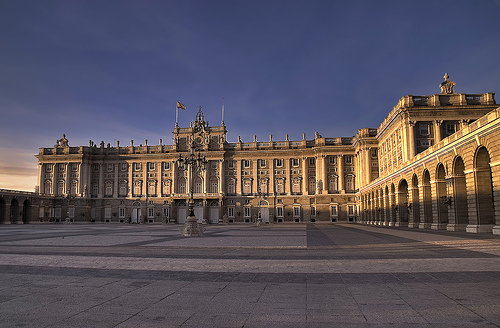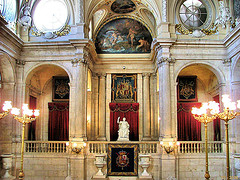



Tel. 91- 454 88 00
Subway: Opera, Plaza de Espana
Bus: 3, 25, 33, 39, 148
Open: Apr- Sep: 9am- 6pm Mon- Sat, 9am- 3pm Sun & holidays;
Oct- Mar: 9:30am- 5 pm Mon- Sat, 9am- 2 pm Sun & holidays
Palacio Real de Madrid or a Royal Palace of Madrid is one of the largest existing royal palaces in Europe. Its collection of art is truly an impressive. Priceless collection of masterpieces of Giovanni Battista Tiepoli, Luca Giordano, Caravaggio, Anton Mengs, Mariano Salvador Mael, Vicente Lopes and many others hang on walls. Additionally Palacio Real de Madrid has a large collection of Stradivarius violas, porcelain, clocks and medieval armor of knights. And all this is only part of the splendor concentrated here. In addition to splendor of Palace Real palace halls you can enjoy peace and quiet of the Royal Library, the Museum of Applied Arts and Royal Pharmacy. Behind the palace you can see beautiful gardens of Campo del Moro that were opened here in the 19th century.
The Royal Palace of Madrid is the official
residence of the King of Spain ; nevertheless, the current kings do
not live in it, but in the Palace of the Zarzuela , reason why it is
used for ceremonies of State and solemn acts
With an area of 135,000 m² and 3418 rooms (on the surface, almost
twice as much as Buckingham Palace or the Palace of Versailles ), it
is the largest royal palace in Western Europe , and one of the
largest in the world. It houses a valuable historical-artistic
heritage, highlighting the set of musical instruments known as the
Palatine Stradivarius , and very relevant collections from other
disciplines such as painting , sculpture and upholstery . The state
rooms and the artistic collections are open to visitors as long as
there are no official acts.
It is also known as Palacio de Oriente, despite being located in the
westernmost part of Madrid , due to its location in Plaza de Oriente
, so called being located east of the palace. To axis with the
palace, and faced, is the other end of the square the Royal Theater
.
The palace was built by order of King Felipe V , on the site left by
the Real Alcázar , destroyed almost entirely by fire in 1734 . Both
the foundations of the old fortress and some of its structures were
used for the construction of the new palace. The episode of the fire
served to justify the replacement of the old building by a palace
according to the taste of the time. Its construction began in 1738 ,
according to architect Filippo Juvara , who proposed a larger palace
but in a different location. When Juvara died, the project was
entrusted to his disciple Juan Bautista Sachetti, who was required
to adapt the plans of Juvara to the site of the old Alcázar. Other
distinguished Spanish architects such as Ventura Rodríguez
participated and were trained in the quarry of the new palace, he
owes the configuration of the Royal Chapel. Francesco Sabatini was
responsible for the completion of the building and reform of
secondary works, expansion and decoration. Carlos III was the first
monarch to inhabit the palace continuously.
The last monarch who lived in the palace was Alfonso XIII , although
Manuel Azaña , president of the Second Republic , also lived in it,
occupying the rooms that had previously occupied the Queen Maria
Cristina and being, therefore, the last head of state did. During
that period it was known as the National Palace . There is still a
room, next to the Royal Chapel, which is known as the "office of
Azaña".
The interior of the palace stands out for its artistic wealth, both
in terms of the use of all kinds of noble materials in its
construction and the decoration of its rooms with works of art of
all kinds, such as paintings by artists of the importance of
Caravaggio , Velázquez , Francisco de Goya and frescoes by Corrado
Giaquinto , Giovanni Battista Tiepolo or Anton Raphael Mengs . Other
remarkable collections that are conserved in the building are those
of the Royal Armory , porcelain , watchmaking , furniture and
silverware .
Currently, Patrimonio Nacional , an autonomous body under the
Ministry of the Presidency , manages publicly owned assets placed at
the service of the Crown, including the Royal Palace.
In 2016, the Royal Palace received more than 1.4 million visitors,
being the seventh most visited monument in Spain.